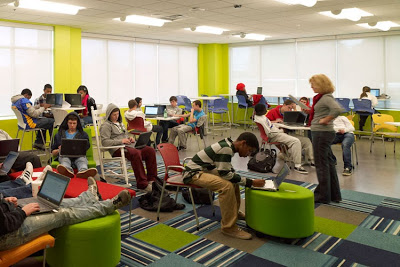Pillars of Digital Leadership Series: Rethinking Learning Spaces and Environments

This post is the sixth in a series that will outline the foundational elements of my new book, Digital Leadership: Changing Paradigms for Changing Times. It is set to be published by Corwin Press on January 14, 2014. Currently there is a pre-publication discount of 15% for any orders before this date. Over the next couple of weeks I will introduce what I have come to identify as the Pillars of Digital Leadership, a conceptual framework for leaders to begin thinking about changes to professional practice. My book will focus on each of these elements as part of a change process. It will illustrate them in action through the work of practitioners and provide implementation strategies. To view the entire series click HERE.
Pillar #6 - Rethinking Learning Spaces and Environments
Digital leadership looks at societal trends as inspirational elements and potential catalysts for change in the structure of the schools themselves as well as the designs of programs. It is a call to action challenging leaders to critically reflect on the learning spaces and environments that embody a school. Do they meet the needs to learners today? Do they foster and inspire creativity, provide flexible opportunities to learn, and address unique and specific interests? Are they reminiscent of what students will expect in today’s world? I will be the first one to admit that the learning environments and spaces at New Milford High School looked nothing like this prior to 2009. Our goal now is to try our best to create a physical space and overall environment that offers flexibility, choice, and tools that our learners will experience upon graduation. With the pedagogical shifts outlined in the last post in this series our success will be determined by the transformation of learning spaces and environments that support these instructional changes.
Clark Hall at GAHANNA LINCOLN HIGH SCHOOL (Columbus, OH)
Digital leadership drives school leaders to look past traditional constructs and incorporate trends embraced by Fortune 500 companies to transform learning spaces and environments. When energy and time are spent in this area, school will not only authentically engage students, but also better prepare them for success in today’s dynamic society. The end result will be opening the door to learning while creating global scholars. Chapter 10 of my book provides leaders with a look into how Principal Dwight CARTER spearheaded such change to create Clark Hall, a model for how schools should function and be structured in the Digital Age. Dwight provides invaluable insight on the journey and processes involved to create an environment that students and teachers alike want to be a part of. Schools today need to focus on creating environments and spaces that:
- provide an open, bright, and flexible space for learning
- provide student choice
- integrate technology to engage students
- are flexible with time to focus on learning
- provide students with the opportunities to express their natural creativity
- utilize teachers as facilitators
- promote interdisciplinary and interconnected projects
- make learning fun
Digital leaders develop a vision and strategic plan to create schools that engage and drive learning. Thanks to social media and the real-time Internet we all have access to design elements and ideas to transform schools into institutions where students use real-world tools to do real-world work. This is where the foundation was laid for the evolving Makerspace at NMHS. In addition to the successes that Dwight has had in this area, the rest of the chapter will look at how schools can create their own Academies as well as create pathways to individualize and personalize learning for all students. How have you worked to redesign learning spaces and environments at in your respective district or school?If you have any specific questions in regards to the Academies @ NMHS, IOCS, or our Makerspace (hyperlinks in the above paragraph) feel free to reach out to me.
cross-posted on A Principal's Reflections
Eric Sheninger is a NASSP Digital Principal Award winner (2012), PDK Emerging Leader Award recipient (2012), winner of Learning Forward's Excellence in Professional Practice Award (2012) and co-author of Communicating and Connecting With Social Media: Essentials for Principals and What Principals Need to Know About Teaching and Learning Science. He presents and speaks nationally to assist other school leaders in effectively using technology. His blog, A Principal's Reflections, was selected as Best School Administrator Blog in 2011 by Edublogs.
Tools and ideas to transform education. Sign up below.
